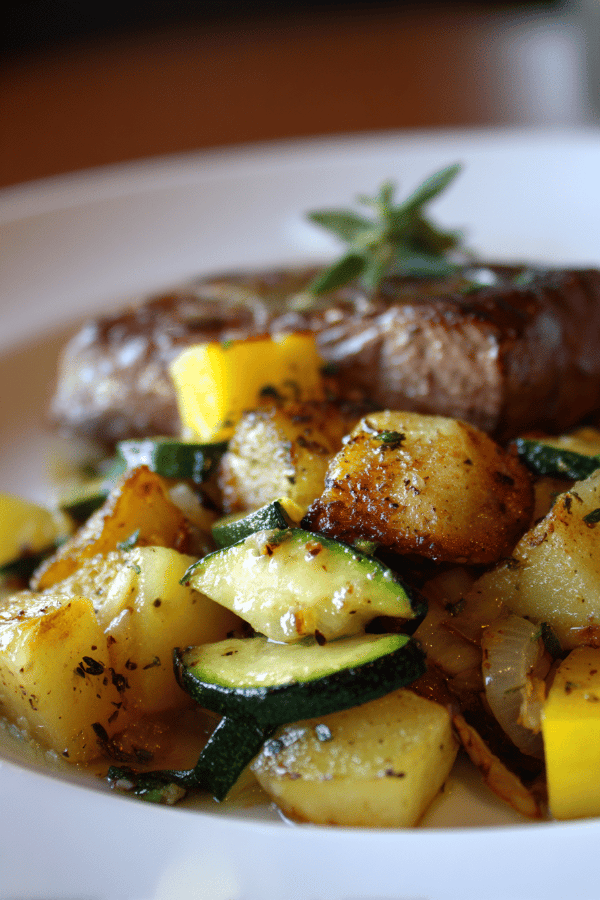Featured Recipe
Beef Steak with Crispy Potato Zucchini

By Kate
"
Lean sirloin steaks seared in butter, rested to hold juices. Sauce whipped up in the same pan—flour to thicken; white port swapped for dry white wine to brighten flavor. Potatoes diced fine, fried in olive oil till golden and crisp, zucchini tossed in near the end to keep slight bite. Salt and pepper balanced throughout. Simple, tactile, honed for kitchen pragmatism. Familiar ingredients with a twist, serving four portions, adaptable for smaller or bigger crowds.
"
Prep:
25 min
Cook:
30 min
Total:
55 min
Serves:
4 servings
beef
main course
dinner
French cuisine
Introduction
Searing steak right—know the signs. Butter foaming, meat releasing nitrogen bubbles, crust that cracks when poked. Rest is non-negotiable; no juice lost to plate. Sauce? No bland puddle. Use fond, flour for body, and sharp white wine over sweet port for brightness. Potatoes crisped separately, then zucchini tossed in LAST—why scramble softness? Textural contrast. Tossing too early? Mush. Cook too fast? Burnt edges. You’ll hear the sizzle, smell that nutty butter with steak aromas mixing with fresh herb notes. Taste so simple but landing right means patience and control. Pan management and timing is key. Four steaks, but slice to serve more or less, ensuring all hit the table hot. Double sauce, halve oil for lighter meals. No shame in substitutions or tweaks.
Ingredients
About the ingredients
Switched to Yukon Gold for creamier texture and faster cooking. Olive oil quantity slightly increased, potato dicing smaller for crisp edges in less time. Butter lowered to avoid burning yet hold flavor. White wine is a flexible substitute for port, adds acidity and depth without the sweetness, better matched with chicken stock. Shallot optional but recommended; adds base flavor to sauce layers. Thyme is a quiet floral herb to replace port’s complexity. Salt and pepper adjustments frequent throughout to keep seasoning balanced, remembering potatoes and beef absorb salt differently. Preparation can be staggered—slice potatoes early and soak if needed, pat dry to prevent oil spatter.
Method
Steak
- 1. Heat butter in heavy skillet over medium-high. Steak should sizzle immediately. Sear steaks 3 to 4 minutes per side for medium-rare. Look for deep brown crust; avoid grey steam steam traps. Season with salt, pepper mid-sear for better crust. Rest steaks tented loosely under foil – resting crucial to reabsorb juices.
- 2. Used pan still hot with browned bits. Lower heat slightly. If adding shallots, sweat them now until translucent but not browned. Sprinkle flour evenly, stir constantly for 1 minute, no lumps. Immediately deglaze with white wine, scraping fond with wooden spoon. Add chicken stock and a sprig of thyme if using. Bubble vigorously to reduce by half or until sauce thickens and coats spoon with a sheen. Final salt and pepper adjustment.
- 3. Heat olive oil in separate skillet, medium heat. Add diced potatoes; fry stirring occasionally. Watch for golden crisp edges and soft interiors, about 6 to 7 minutes (longer if cut larger). Add diced zucchini last 4 minutes; keep them al dente. Season with salt and pepper. Don't overcrowd pan; potato pieces should sizzle freely, no steam. If needed, fry in batches.
- 4. Slice steaks thin if smaller servings preferred. Plate crispy potatoes and zucchini alongside. Spoon warm sauce over steaks or on side. Thyme sprigs or fresh herbs scattered for aroma.
- 5. Leftover sauce thickening too much? Thin with splash of stock or wine; too thin? Reduce longer. Resting meat and veggie timings can overlap to save time.
Vegetables
Serve
Technique Tips
Searing requires medium-high heat—not scorching flames or fat waste. Listen—steady sizzle, color shifts from red to a tight brown crust; poke with finger or tongs for firmness—a soft spring registers rare, firm edges mean well done. Flour sprinkled off heat to avoid lumps. Deglaze immediately to lift fond and integrate flavor. Sauce reductions need bubbles breaking surface steadily; stop once nappe stage reached—thick enough to coat the back of a spoon but not gluey. For potatoes, crowding tanks the pan temperature; troubleshoot by batch frying or using bigger pans. Zucchini added late to keep bite and color. Mix gently to avoid breaking cubes. Resting meat tented loosely traps residual heat but prevents sogginess. Timing overlaps—start potatoes while steak cooks. Spoon sauce last minute; reheat gently if made ahead.
Chef's Notes
- 💡 Sear steaks well to achieve that crust. Check heat. If butter foams, good sign. Look for that golden brown while cooking. Not grey. Special attention on timing for thickness. Let them rest after.
- 💡 Potatoes need proper pressure while frying. Even size, smaller is better for crispy edges. Olive oil should be hot but not burning. Sizzle is key. Don’t overcrowd. More moisture or longer time equals sadness.
- 💡 Zucchini last in frying pan. Watch to not mush them. Cooked too long, and they lose crunch. Avoid mushiness by timing right. They should look vibrant, not drab green. Stir gently or risk breaking.
- 💡 For sauce, fond at bottom of the pan—key flavor source. Scrape it up while deglazing. Flour early in, watch lumps. Reduce until it coats spoon. No gloppiness; nappe stage is the goal.
- 💡 Timing overlaps can save minutes. Start potatoes while searing meat. Rest meat tented; keep it warm. Sauce can be prepared ahead. Reheat gently; avoid burning. Think ahead for timing.
Kitchen Wisdom
How to check steak doneness?
Look for color changes. Squeeze gently. A soft feel means rare. Firmer means well done. Keep in mind it needs resting.
My sauce turned out thin, what now?
Reduce longer. Adds concentration. Or add some cornstarch mixed with water. Quick thickener. Just don’t overdo it.
Zucchini too soft, help?
Add them in late stage of frying. Cook for just a few minutes. The crunch matters. They should retain color too.
Storage options for leftovers?
Cool everything quickly. Store sealed. Fridge is fine. Steaks can be reheated low and slow. Potatoes, crispy again in oven.



